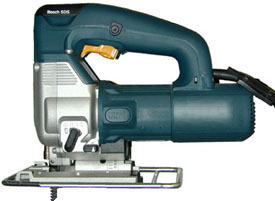| Production > Vibration |
 Woodworking tools may cause vibration that could lead to "white fingers" or hand-arm
vibration syndrome (HAVS). This is especially dangerous when proper damping techniques are not
applied, if machines are not maintained, if tools are not alternated, or if a worker uses a vibrating
tool for consecutive hours during a workday. Workers need to be trained on the hazards of working with
vibrating tools and always should allow the tool or machine to do the work.
Woodworking tools may cause vibration that could lead to "white fingers" or hand-arm
vibration syndrome (HAVS). This is especially dangerous when proper damping techniques are not
applied, if machines are not maintained, if tools are not alternated, or if a worker uses a vibrating
tool for consecutive hours during a workday. Workers need to be trained on the hazards of working with
vibrating tools and always should allow the tool or machine to do the work. |
|
|
|
|
Potential Hazards:
- Both hand-held and stationary tools that transmit vibration through a work piece can cause
vibration "white fingers" or hand-arm vibration syndrome (HAVS). White fingers, or
Raynaud's Syndrome, is a disease of the hands in which the blood vessels in the fingers
collapse due to repeated exposure to vibration. The skin and muscle tissue do not get the
oxygen they need and eventually die. HAVS is a more advanced condition, and the entire hand or
arm may be affected by exposure to vibration. Early signs of HAVS are infrequent feelings of
numbness and/or tingling in the fingers, hands, or arms, or numbness and whiteness in the tip
of the finger when exposed to cold. As the disease progresses, a worker experiences more
frequent attacks of numbness, tingling, and pain and finds it difficult to use his or her
hands. A worker with advanced HAVS may be disabled for a long time.
Possible Solutions:
Engineering Controls
- Vibration isolators or damping techniques on equipment offer the most effective protection.
Isolate machine vibrations from the surface if it is mounted or by use of vibration-isolation
mounts. Vibrating panels of machine housings and guards may be controlled by use of damping
materials applied to the panels. Felts, liquid mastics, and elastomeric damping sheets are
effective damping materials. Determining the correct type and quantity of damping material to
use for a particular machine is a complicated process and should be left to a knowledgeable
person. The frequency emitted by the machine, the noise reduction level desired, and the
weight and size of the machine are factors to consider. A good rule of thumb, however, is that
the damping layer should be the same thickness as the surfaces being treated.
Work Practices
- Maintain machines in proper working order. Unbalanced rotating parts or unsharpened cutting
tools can give off excessive vibration.
- Arrange work tasks so vibrating and nonvibrating tools can be used alternately.
- Restrict the hours a worker uses a vibrating tool during the workday. Allow employees to
take 10 - 15-minute breaks from the source of the vibration every hour.
- Train workers about the hazards of working with vibrating tools. Instruction should include
the sources of vibration exposure, early signs and symptoms of hand-arm vibration syndrome,
and work practices for minimizing vibration exposure.
- Instruct workers to keep their hands warm and dry and to not grip a vibrating tool too
tightly. Workers should allow the tool or machine to do the work.
|
|
 |
|
|
|

